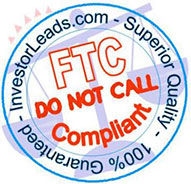Cold Calling Is Back
Dialing for dollars is not dead. In fact, now may be the best time to give the strategy a shot, when calling Financial Investor Leads.
If you visit a good financial advisor at his office, chances are good you’ll find him with his ear pressed to the phone, pitching his services to people he’s never met: That’s right, cold calling. One financial advisor with Merrill Lynch who has been in the business since 2002, spends about 30 to 35 hours a week dialing for dollars and he says it’s time well spent. In fact, these days, oddly enough, he’s finding a lot more willingness on the other end of the line to hear him out. “Cold calling is how I built my practice,” says Andy, who manages about $52 million in assets. “But, people are a lot more likely to take my phone call now than 12 months ago,” he says. While Andy also engages in the usual networking strategies to drum up new business, 65 percent of his clients have come to him either directly through cold calls or through referrals from those clients.
You might have thought cold calling for clients was dead. These days, most wealth management coaches will tell you it’s all about referrals and making wealthy connections and friends at country clubs and local charities. But in some corners of the industry, cold calling is still very much alive and well, in spite of the popularity of the National Do Not Call Registry, established by federal law in 2008. Indeed, Andy is not the only advisor who says these are the best of times for cold calling. That’s because many prospects, recently savaged by the market’s decline, are still disappointed by their current advisors’ performance and more receptive than they might have been during better days to a well-timed approach from a friendly, confident professional.
“They’re more open to a call now,” agrees William Chettle, a marketing expert with Loring Ward, an asset management provider in San Jose, Calif.
Cold calling financial leads isn’t everyone’s cup of tea. It involves hard work and persistence, intruding on strangers’ lives, often while they’re at home, and a thick skin. “Anybody doing cold calling has to be prepared for a steep hill to climb,” says Philip Palaveev, president of Elmsford, NY-based Fusion Financial Network. Plus, because you can’t see your prospect or get a read on his or her facial expression, “A cold call is harder than a face-to-face appointment any time,” says John Graziano, president of Future Financial Planners in Bayonne, NJ, who trains and supervises 120 financial planners in cold calling and other techniques. For that reason, the advisors who choose to make cold calling the mainstay of their marketing efforts probably represent a minority, he says. According to Chettle, just 35 percent of the advisors he works with use cold calling. But most of them turn to it “from time to time,” to supplement other efforts, he says.
The bottom line: Cold calling financial investor leads can pay off. But there’s no point in using it, either as a way to build your practice or supplement existing business, unless you know how to do it right — and really commit yourself to the process.
The first step is finding the right list to work from. Of course, trolling through the Yellow Pages is a thing of the past. In fact, the better the list, the more effective your cold calling will be. That means buying pre-qualified lists of prospects or putting together your own — anything from attendees of previous seminars you’ve held or conferences you’ve attended to people who have used certain financial services or live in specific zip codes.
Or you can try more creative methods. Consider Seth Green, CEO of Silver Spoon Personal Financial Officers in Williamsville, NY. He places ads aimed at lead generation in relevant online and print publications directed at specific target markets, directing readers to a web site or 800 number to request free information. Then, he captures that information and creates his own list.
There are other considerations, as well. Andy uses the Merrill Lynch contact management system to make sure he’s not calling existing Merrill customers. And all lists have to be scrubbed for individuals on the Do Not Call Registry, which is maintained by the Federal Trade Commission (FTC).
You can avoid that last issue if you focus on businesses, rather than households. What’s more, calling businesses has other advantages, as well. Take Dan Hansen, a Chicago-based advisor with Cantella who has $250 million in assets. He focuses on the 401(k) and retirement plan market, dealing primarily with CFOs and business owners. He finds it easier to grab the attention of CFOs than retail clients when cold calling, because they have a fiduciary responsibility to at least hear him out. “They’re obligated to talk to someone like me when I call,” he says. He also finds it easier to buy more targeted, informative lists of prospects. For example, he subscribes to a database provider through which he has access to data from company documents filled out every year about retirement plans. As a result, even before he picks up the phone, he already knows the name of each company’s current plan, total assets and other useful information.
Whether you’re targeting businesses or households, common wisdom is that cold calling is entirely a numbers game. While there’s no hard and fast rule about just how many calls you need to make, veterans advise you try for several hundred calls in one session. Andy, for one, makes 250 to 400 calls a day. “The more phone calls, the more appointments you get,” says Graziano. “And the more appointments, the more business you get.”
I’m Calling You
Certain words are the kiss of death when it comes to cold calling.
“Customers can sense it when you say things that make you seem less powerful,” says Vickie Bouffard, who runs Quantum Performance Training in Phoenix, AZ.
Here are some do’s and dont’s:
Don’t: “I wonder weather you might like to have a cup of coffee?”
Do: “Would you like to have a cup of coffee?”
Don’t: “I’m just a financial planner…”
Do: “I”m a financial planner…”
Don’t: I’ll try to call you back.”
Do” “I’ll call you back.”
But not everyone sees it that way. There’s a vocal minority who opt for longer, more in-depth calls. Green, for one, trains advisors to make no more than 30 calls a day, searching for specific gaps — a portfolio with too-risky investments, say — and then encouraging lengthy conversations before finally arranging a meeting. Similarly, Chettle recommends that his advisors contact a small number of carefully researched prospects and to accompany each call with supporting materials. He points to an advisor in Florida who is targeting academics in his area with a six month campaign during which he plans to call 150 potential clients and then follow up with a white paper on retirement issues and other material. “You have to offer more value,” he says.
You’ll also need to write out at least a general idea of what you’ll say — the more experienced you are, the less you’re likely to rely on a script — and to plan ahead of time how to handle potential objections. You can figure you have 10 to 30 seconds to establish just who you are and why you’re worth talking to and to suss out the prospect’s needs. (Examples of introductory questions: “What types of goals are you working toward?” or “What have done to plan for your retirement?”) Remember: Rule of thumb is you’re not trying to sell a product. Your goal is to arrange a face-to-face meeting. One way to fine tune your spiel: Study how other successful cold callers do it. When Andy joined Merrill Lynch, for example, he approached several veterans and asked them for their most effective lines.
These days, however, it’s also important to find ways to tap prospects’ potential discontent with existing advisors. Case in point is Todd Schoenberger, managing director of LandColt Trading, a San Antonio, Tex., firm that sells trading models via subscription, mostly to retail investors. He comes right out and asks whether prospects are working with an advisor. If they are, then he asks how the relationship is working out. “That opens up a window if they’ve been burned,” he says.
To that end, it’s also important to determine how often prospects’ advisors communicate with them and review their portfolios. Andy, for one, recently called a prospect who revealed he not only worked with three advisors, but had never reviewed all his holdings together at one time. So, Andy suggested they do so. Soon after that they met, and the man moved all his assets over to Andy. Another tack is to propose a second opinion, offering to take a look at a prospect’s portfolio free of charge.
In some cases, however, the economic downturn may not work in your favor. That’s particularly true if you’re dealing with businesses. Take Hansen. Although he had a lot of success at the end of 2008 before many businesses really started feeling the pinch, more recently he’s had a much harder time of it. While CFOs take his calls, they usually reveal they’re more concerned with survival than changing their 401(k) plan. For Hansen, the message is clear: It’s time to back off. “I don’t push as hard as I used to,” he says.
But, more often than not, if someone doesn’t want to talk, then it’s best to offer to call back — and ask for a specific day or time to do so. Then put it on your calendar and follow through. If you call back and the person still puts you off, then arrange another time to call. Andy says it took 18 months of persistent follow through before the man who became his biggest client agreed to meet several years ago. You can also reinforce your message by emailing something of interest (or using snail mail if you think that would be more effective) shortly before you call again.



